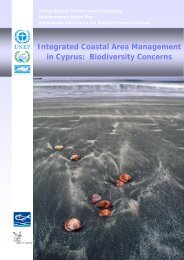Proceedings of the Second Mediterranean Symposium on Marine
Proceedings of the Second Mediterranean Symposium on Marine
Proceedings of the Second Mediterranean Symposium on Marine
You also want an ePaper? Increase the reach of your titles
YUMPU automatically turns print PDFs into web optimized ePapers that Google loves.
PROCEEDINGS OF THE SECOND MEDITERRANEAN SYMPOSIUM ON MARINE VEGETATION (ATHENS, 12-13 DECEMBER 2003)<br />
80<br />
Mature tetrasporangia are spherical; tetrahedrically divided and measure 35-40 µm in<br />
diameter. In culture, tetrasporangia are so<strong>on</strong> released as a unit and numerous spores<br />
germinate. Germinati<strong>on</strong> follows <str<strong>on</strong>g>the</str<strong>on</strong>g> Gelidium-type pattern.<br />
Thalli <str<strong>on</strong>g>of</str<strong>on</strong>g> <str<strong>on</strong>g>the</str<strong>on</strong>g> Apulian Batophora sp. col<strong>on</strong>ise st<strong>on</strong>es (Fig. 4a) at 0-3 m depth. Plants are<br />
bright green, s<str<strong>on</strong>g>of</str<strong>on</strong>g>t and delicate. The thallus c<strong>on</strong>sists <str<strong>on</strong>g>of</str<strong>on</strong>g> a cylindrical stalk, sometimes<br />
branched (Fig. 4b), attached to <str<strong>on</strong>g>the</str<strong>on</strong>g> substrate by rhizoids, and numerous whorls <str<strong>on</strong>g>of</str<strong>on</strong>g><br />
laterals. Reproductive organs were never observed <strong>on</strong> ei<str<strong>on</strong>g>the</str<strong>on</strong>g>r field or lab-cultured thalli.<br />
Fig. 4.Batophora sp. Detail <str<strong>on</strong>g>of</str<strong>on</strong>g> (a) an unbranched thallus; (b) a branched thallus.<br />
Careful morphological and morphometric observati<strong>on</strong>s highlighted that <str<strong>on</strong>g>the</str<strong>on</strong>g> thalli <str<strong>on</strong>g>of</str<strong>on</strong>g><br />
Dasycladus were smaller than those <str<strong>on</strong>g>of</str<strong>on</strong>g> Batophora and never branched; <str<strong>on</strong>g>the</str<strong>on</strong>g>ir main axis<br />
was 4-6 times wider and <str<strong>on</strong>g>the</str<strong>on</strong>g> first order laterals were shorter and more numerous (Fig.<br />
5a, b).<br />
In regard to diagnosis at species level, according to Berger and Kaever (1992) in <str<strong>on</strong>g>the</str<strong>on</strong>g><br />
genus Batophora <str<strong>on</strong>g>the</str<strong>on</strong>g> species are distinct <strong>on</strong> <str<strong>on</strong>g>the</str<strong>on</strong>g> basis <str<strong>on</strong>g>of</str<strong>on</strong>g> a few vegetative characters but<br />
above all <strong>on</strong> <str<strong>on</strong>g>the</str<strong>on</strong>g> basis <str<strong>on</strong>g>of</str<strong>on</strong>g> <str<strong>on</strong>g>the</str<strong>on</strong>g> reproductive <strong>on</strong>es. Comparis<strong>on</strong> between Mexican and<br />
Apulian specimens pointed out some slight differences, probably due to <str<strong>on</strong>g>the</str<strong>on</strong>g> different<br />
geographical and climatic c<strong>on</strong>diti<strong>on</strong>s (Table 6).<br />
Fig. 5.Batophora sp. Scheme <str<strong>on</strong>g>of</str<strong>on</strong>g> a whorl in (a) Dasycladus and (b) Batophora.














